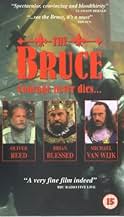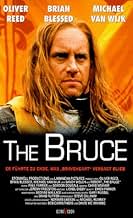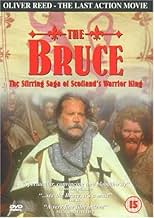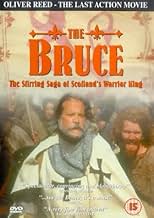Añade un argumento en tu idiomaIn the early 14th century, Scottish warrior and Earl Robert the Bruce is crowned King of Scots, leading Scotland during the First War of Scottish Independence against England.In the early 14th century, Scottish warrior and Earl Robert the Bruce is crowned King of Scots, leading Scotland during the First War of Scottish Independence against England.In the early 14th century, Scottish warrior and Earl Robert the Bruce is crowned King of Scots, leading Scotland during the First War of Scottish Independence against England.
- Dirección
- Guión
- Reparto principal
Barrie Ingham
- Gloucester
- (as Barry Ingham)
Heather Flannagan
- Majorie Bruce
- (as Heather Flannigan)
Reseñas destacadas
Reed, Blessed, Welch and van Wijk all turn in quality performances in this under-rated account of Scotland's greatest warrior (are you watching William Wallace?) but one cast member stands head and shoulders above his colleagues. In the final set, Stuart Poole, clad in garb to make Robin Hood jealous, congratulates the Bruce on his vanquishing of the foe. The dignity, grace and emotion evident in Poole's performance is a joy to behold. It's a shame he isn't credited on imdb...
What was the most irritating thing about this film?
The appalling acting? The revelation that medieval knights apparently fought with an assortment of *very* wobbly rubber axes and other assorted joke shop armaments (honestly, a Pythonesque cow flip would not have been misplaced). The fact that one of the most important battles in 14th century Europe looked more like a disorganised pub fight, with no discernible cues to the viewer as to who was English or Scottish? The incomprehensibly boring narrative? The most ham-fisted, cheesiest, cliché ridden 'tottie-scone' dialogue, ever?
Perhaps all of the above.
To me, however, there was a general eclipse of all that. It was the following.
The quest for Scottish Independence was decades in the making. It saw some of the most deftifying, heroic, savage, heartbreaking and bloodthirsty history that's ever been. We're talking about a time that, when the Scottish defensive wall at Berwick developed a weak spot, children and woman were sent to fill the place to keep the invader out. Every man, woman and child was at war.
In 1996 Scotland deserved a 'proper' movie. Yes, Braveheart was a movie that *deserved* to be made, in it's identification and selling of Scottish history - I applauded it's success - but in doing so I also openly acknowledged the fact that it was a bad film. A very bad film.
Consequently, 'The Bruce' served only to mutilate and befoul not only history itself, but the chance of one day exploring that history in a better capacity than Braveheart ever did - through film - by simply telling the story (trust me, a Screenwriter's dream - as it is, left well alone) on the back of a good budget and high-profile pitch.
The Director of the Bruce should be trialled for Cultural crimes and then, publicly, carted naked through the old streets of Edinburgh, before slowly being drawn against 'The Maiden'.
Shooting adverts for spam products might have been a challenge for him. Instead, he created the single worst movie on the planet (in every conceivable sense) with material that would have gifted a talented directorial new-start with a plethora of creative devices and opportunity.
In short, I wanted to scoop my own eyes out and replace them with cartoon bomb-jacks. And, in short, he ruined it for real directors of the future.
The appalling acting? The revelation that medieval knights apparently fought with an assortment of *very* wobbly rubber axes and other assorted joke shop armaments (honestly, a Pythonesque cow flip would not have been misplaced). The fact that one of the most important battles in 14th century Europe looked more like a disorganised pub fight, with no discernible cues to the viewer as to who was English or Scottish? The incomprehensibly boring narrative? The most ham-fisted, cheesiest, cliché ridden 'tottie-scone' dialogue, ever?
Perhaps all of the above.
To me, however, there was a general eclipse of all that. It was the following.
The quest for Scottish Independence was decades in the making. It saw some of the most deftifying, heroic, savage, heartbreaking and bloodthirsty history that's ever been. We're talking about a time that, when the Scottish defensive wall at Berwick developed a weak spot, children and woman were sent to fill the place to keep the invader out. Every man, woman and child was at war.
In 1996 Scotland deserved a 'proper' movie. Yes, Braveheart was a movie that *deserved* to be made, in it's identification and selling of Scottish history - I applauded it's success - but in doing so I also openly acknowledged the fact that it was a bad film. A very bad film.
Consequently, 'The Bruce' served only to mutilate and befoul not only history itself, but the chance of one day exploring that history in a better capacity than Braveheart ever did - through film - by simply telling the story (trust me, a Screenwriter's dream - as it is, left well alone) on the back of a good budget and high-profile pitch.
The Director of the Bruce should be trialled for Cultural crimes and then, publicly, carted naked through the old streets of Edinburgh, before slowly being drawn against 'The Maiden'.
Shooting adverts for spam products might have been a challenge for him. Instead, he created the single worst movie on the planet (in every conceivable sense) with material that would have gifted a talented directorial new-start with a plethora of creative devices and opportunity.
In short, I wanted to scoop my own eyes out and replace them with cartoon bomb-jacks. And, in short, he ruined it for real directors of the future.
Robert Bruce died in 1329. According to Jean Froissart, when Bruce was dying he asked that Sir James Douglas, as his friend and lieutenant, should carry his heart to the Holy Land and present it at the Holy Sepulchre in Jerusalem as a mark of penance. John Barbour, alternatively, has Bruce ask that his heart should simply be carried in battle against "God's foes" as a token of his unfulfilled ambition to go on crusade. Given that Jerusalem had been in Muslim hands since 1187, this second is perhaps more likely. When Bruce was dead, his heart was cut from his body and placed in a silver and enamelled casket which Sir James placed around his neck. Early in 1330, Douglas set sail from Berwick upon Tweed, accompanied by seven other knights with twenty six squires and gentlemen. The party stopped first at Sluys in Flanders. There it may be that Douglas received confirmation that Alfonso XI of Castile was preparing a campaign against the Muslims of the kingdom of Granada. In anticipation, he had with him a letter of introduction to King Alfonso from Edward III of England, his cousin. Accordingly, the Scots sailed on to Seville, where, according to John Barbour, Sir James and his solemn relic were received by Alfonso with great honour. Douglas and his company joined Alfonso's army, which then was setting out for the frontier of Granada to besiege the castle of Teba. Uthman, the Berber general in command of the Moorish forces, marched to relieve the border stronghold. At some point during the siege, Douglas was killed. Sources and commentators differ as to how. According to Jean Froissart and the Gran Cronica de Alfonso XI, Douglas was killed as a result of making a premature attack on the enemy. The Gran Cronica suggests this might have been during fighting for access to water. Citing John Barbour, some modern commentators believe he died in the decisive Battle of Teba. [16][17] Barbour describes a grand battle in Spain but the setting is vague and the outcome ambiguous. According to the Gran Cronica de Alfonso XI, Uthman, unable to bring the Christians to battle, devised a stratagem in an attempt to force them to abandon the siege. A body of cavalry was sent to make a diversionary attack across the Guadalteba river, luring Alfonso out to fight while Uthman circled round to attack the Christian camp and destroy the besieging army's supplies. Alfonso, however, having received intelligence of Uthman's preparations, kept most of his army back in camp while he sent a contingent to meet the demonstration on the river. It is as part of this force that some commentators assume Douglas and his company joined the battle.[18] When Uthman arrived at the enemy camp he found Alonso's men armed and ready. He abandoned his attack and rode to support the diversionary force on the river where, unable to withstand the Castilian assault, his men were already starting to fall back. Uthman arrived too late to prevent a general rout and the entire Granadan force was driven back in confusion to their camp in the Turon valley, 10 miles to the south. It is in this phase of the battle that some modern commentators have placed Douglas' death, either caught in flank when Uthman's force reached the river or in the ensuing pursuit to the Granadan camp. According to John Barbour's description of Douglas' last battle, when the enemy broke, Sir James and his companions followed hard behind. Having outstripped most of his men in the pursuit, Douglas suddenly found himself far out in front with only a few of his followers around him. As he rode back to rejoin the main body, he saw Sir William St. Clair of Rosslyn surrounded by a body of Moors who, seizing their opportunity, had quickly rallied and counterattacked. With the few knights who were with him, Douglas turned aside to attempt a rescue but, outnumbered twenty to one, the group was overrun. It has become a popular legend that Douglas then took from his neck the silver casket which contained the heart of Bruce and threw it before him among the enemy, saying, "Now pass thou onward as thou wert wont, and Douglas will follow thee or die."[19] This anecdote has its origin in a 16th century addition to Barbour's poem which, however, describes Douglas making the gesture at the beginning of his final battle. It was Sir Walter Scott in Tales of a Grandfather who created the image of Douglas throwing Bruce's heart as his dying act.[20] The Castilian cronica makes no reference to such a catastrophe. It does, however, state that in a fierce skirmish some days prior to the climactic battle, an unnamed 'foreign count' (arguably a reference to Douglas), had died as a result of his own rash behaviour. This is one of only two battle casualties mentioned individually in the Castilian narrative of the campaign. Barbour relates that Sir James and all the men caught with him were killed, including Sir William St. Clair of Rosslyn and Sir Robert Logan of Restalrig. Barbour states that, after this battle, Douglas' body and the casket with Bruce's heart were recovered. His bones, the flesh boiled off them, were taken back to Scotland by Sir William Keith of Galston in Ayrshire (who had missed the battle because of a broken arm), and deposited at St Bride's chapel. The tradition that Sir Simon Locard was a member of the company and also survived, is not found in any of the sources. The heart of Bruce was taken by Moray, the regent, and solemnly interred under the high altar of Melrose Abbey. (see wikipedia for the full article with notes) the heart of the Bruce was added to the Douglas arms sometime following the death of Sir James.
From the annals of Scotish history comes this story and film which tells the legend of Robert " The Bruce (Sandy Welch)." The Scots, having endured years of brutal English rule, once again take up arms against the insufferable tyranny and do so under a new crown king of Scotland. England is ruled by Edward I, the brutal king of England in this film played by Brian Blessed, who plays it to the hilt. Other notables in the film are Oliver Reed and Michael Van Wijk. The movie itself is lased with an assortment of English and Scotish notability, but because the director Bob Carruthers decided to keep all characters in 'scrag' weaponry, motley costumes, shaggy long hair, five day old beards and despicable dress even after war time battles, everyone in the film are terrible looking to the audience members. As such, one can hardly distinguish between friend and for alike. The battle scene are authentic looking, but if you have a 'stop-frame' recorder, you may notice that several combatants fighting each other are not very convincing. In many respects, this movie should follow historically on the footsteps of the Mel Gibson film ' Braveneart. ' As such, the audience does it's best to follow The Bruce with patience and understand. So enjoy it if you can, but don't expect too much. I'll recommend it because the late Oliver reed is in it. ****
To be fair this film was never intended for the big screen, it was made at a time when everyone was buying DVD players and needed to stock up on cheap discs to buff up their collections! Yes it is a bad film, dubious acting, grainy film, and poor battle scenes, but give the film a break, it does have a couple of household names in it, and the history (although slanted and very pro Bruce) is at least far more favourable than its block busting, older sibling 'Braveheart'(which this film is obviously a low budget cash-in of!). Bruce is played competently by Sandy Welch, who portrays the Scottish icon in a sympathetic light, and Pavel Douglas is fantastically over the top as the nasty Red Comyn! Brian Blessed gives a crazy but fulfilling turn as King Edward, and Ollie Reed does good as the bishop! People who are complaining about this film are just negatively comparing it with 'Braveheart', and this is not really fair, the film delivers an account of Robert The Bruce's life, and does so on a very low budget! It is perhaps, too over ambitious, but fitting an epic struggle lasting 25 years into a 110 minute film is reason enough for applause! It would work well as a school film to give kids a history lesson they can expand on later, but its target audience is the couch potato (GUILTY AS CHARGED!), and we don't need $79 million spent on a film, just so long as it tells a good story! Even Wolf from Gladiators gives an OK performance, and if that isn't enough, Robin Hood makes a guest appearance at the end of the film! If its a rainy Wednesday afternoon and the wife is out,and 'Loose Women' is on TV, you will probably be a lot happier giving up an hour and a half on this film than watching the previously mentioned programme!!
¿Sabías que...?
- CuriosidadesA Dunfermline schoolgirl skipped school one day and landed a part in this, crowning Robert the Bruce. She went on to film other scenes, including a corpse. Although she never got paid, she claims it was the most exciting thing that happened. She was shy because she'd never been in front of a camera before, but she found it easy, as the set was closed when Oliver Reed was in the coronation scene. The crown on Sandy (Robert The Bruce) kept slipping off his wig . He told the girl that inside was a dot which was supposed to sit at the back. This helped. The next scene was perfect and they kept it in the film, where she smiles at her friends next to her, happy that it stayed on.
- Créditos adicionales"This film was only made possible by the faith and courage of the Associate Producers". This is followed by a list of the names of over 200 individuals and organisations.
- Versiones alternativasUK versions were cut by 16 secs by the BBFC to remove all shots of women's bloodstained breasts.
Selecciones populares
Inicia sesión para calificar y añadir a tu lista para recibir recomendaciones personalizadas
- How long is The Bruce?Con tecnología de Alexa
Detalles
Taquilla
- Presupuesto
- 500.000 US$ (estimación)
- Duración
- 1h 47min(107 min)
- Mezcla de sonido
- Relación de aspecto
- 1.66 : 1
Contribuir a esta página
Sugerir un cambio o añadir el contenido que falta

























